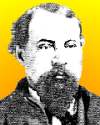 (source)
(source)
|
George Brayton
(3 Oct 1830 - 17 Dec 1892)
American engineer who invented the first commercial gas internal combustion engine. Its principle of continuous ignition later became the basis for the turbine engine.
|
The Brayton Engine and Cycle.
from The Automobile Book: A Practical Treatise (1916)
The Lenoir and the Otto engines were both of European origin, but America was not behind. Without mentioning an early patent of about 1845, which described a fairly practicable air-cooled gas engine, we have the work of George W. Brayton, who developed the Brayton cycle, an engine of the two-stroke type, operating much as a steam engine. In this engine air and liquid fuel were admitted into the cylinder of the engine, burning as they entered. This liquid fuel, being constantly present, and entering as did the air, in varied amount, rather than intermittently, continued to burn between impulses, so that on the opening of the inlet valve, a large burst of flame would fill the working cylinder, and drive the piston before it to the end of its stroke. At this point the exhaust valve would open and permit the diminished flow of air and fuel to escape. On the closing of the exhaust valve at the end of the exhaust stroke, the inlet valve would open; again admitting a large charge of air and fuel, which, because of the flame carried over from the last action, would burn rapidly and repeat the performance. To provide for the admission of air and fuel, the engine operated a pump, which pumped air into a storage tank and also pumped liquid fuel as needed. It will thus be seen that the air tank served as a boiler, but that the flame, instead of being applied to the tank, to expand the air, as commonly applied to a steam boiler, was mixed with and applied to, or, in other words, by combustion combined with, the small portion of air used at each individual impulse.
Use of the Brayton Engine.
The Brayton engine was a distinct step forward as a prime mover, and found a considerable sale, which was continued on the American market, and, to some extent, on the English market, until about 1885 or 1887, or even later. While not so early as the Lenoir, they were really the first practical gas or liquid-fuel engines in the world, and are entitled to recognition as such. Not only were they used for stationary service, but were applied to boats; to an experimental street car at Providence, R. I.; to a passenger omnibus at Pittsburgh, Pa., and to other more or less interesting uses, such as the pumping of water in the aquarium at the Centennial Exposition of 1876. The Brayton engine, although somewhat more complicated than the Lenoir or Otto, worked on a more economical cycle and ran nearly as smoothly as a steam engine. It could use almost any kind of liquid or gaseous fuel, which was a distinct advantage at that time, when kerosene was still more or less plentiful. While quite simple in operation, it required a working cylinder and a pumping cylinder, which involved a considerable power loss, because of the friction of the pump parts. These engines are probably best known to modern automobile students because of the famous Selden patent, which showed an engine of this type.
- 3 Oct - short biography, births, deaths and events on date of Brayton's birth.
- George Brayton's Engine in Boat Trial - Experimental use of a Brayton engine to power watercraft, described in a letter in Manufacturer and Builder (1880)
- George Brayton - Obituary from Cassier's Magazine (1912).
- George Brayton's Engine - from Transactions of the ASME (1902).
- George Brayton's Engine - A description originally written in 1875, and updated in Johnson's (revised) Universal Cyclopaedia.
- Internal Fire: The Internal-Combustion Engine 1673-1900, by C. Lyle Cummins, Jr. - book suggestion.




